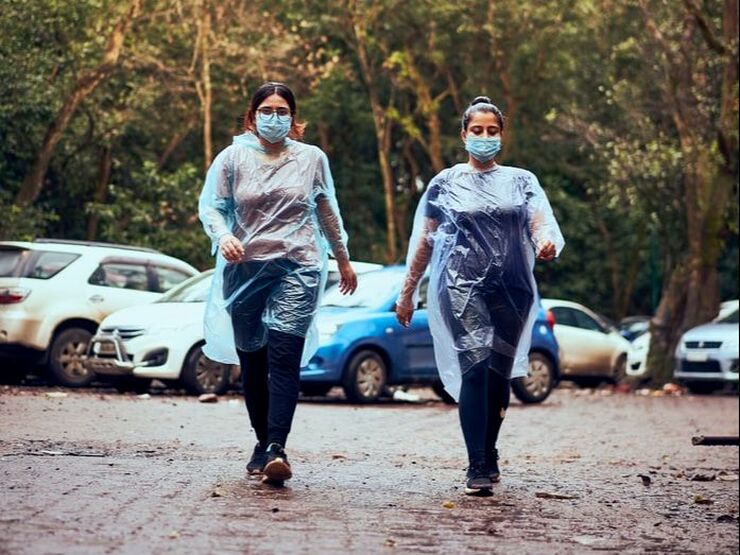|
The economic crisis in India has worsened due to the impact of COVID-19, laying bare the many inequities along the lines of gender. The socio-cultural moorings of the country will be a crucial determinant of how and in what degree the economic crisis affects different sections of the society, making women one of the worst affected communities by the recession and the pandemic at hand.
Women at home With the nationwide lockdown and the consequent curtailment of mobility, families have been deprived of frameworks of solidarity existing outside the ambit of their houses. A report released by GSM Association in the year 2020 reveals that the gender gap between men and women for mobile ownership in India is as much as 20%. Women are often caught within abusive and repressive household environments with limited contact to the world outside. During the first few months of the lockdown, 1,477 complaints of domestic violence were registered by women – a number greater than that recorded in the same period in the last ten years.
Women continue to be allocated increasingly lesser resources within families, leaving them with a dearth of resources like nutrition and healthcare. This becomes worse in the face of crisis. The gender disparity emerging out of the India’s vaccination drive stands testimony to this bias within households: according to government data, out of the 309 million COVID vaccine doses administered between January 2021 and June 2021, 143 million were administered to women compared to the 167 million doses to men.
In many households, women shoulder the primary responsibility of child and elderly care. Dalberg, a strategic advisory group, reported that Indian women do 10 times more unpaid care work than Indian men. COVID-19 has increased the burden of caregiving on Indian women by about 30%. Women become extremely time poor as they try to meet the domestic demands of the pandemic within their households. There needs to be a considerable shift from the masculinist understanding of what qualifies as ‘labour’ and consequently, housework must be accorded its due dignity for women to lead more fulfilling lives and recover from the setbacks of the pandemic. Women in school Young girls face various systemic barriers in their attempt at securing a dignified education in India – marriage, the exclusive burden of housekeeping, social norms around mobility of women and pressing financial problems are some of the reasons which pull girls out of school. During the pandemic, a staggering 10 million girls from secondary schools in India are at the risk of dropping out of schools. The Annual Status of Education Report 2020 reveals that only 8.1% of students enrolled in government-run schools are attending live online classes. This becomes worse for women as they are often relegated to the bottom of resource allocation chains within households, emerging from and resulting in the lower bargaining power they exert within families. The shift to online modes of teaching coupled with the pressing income crises which a large demography of India faces today, female students bear the primary brunt of exclusionary modes of education. This is likely to disincentivise parents from sending girls to school and force many girls to discontinue their studies. The closing of schools as a preventive measure against COVID-19 deprived female students of various government schemes and measures. Mid-day meals (MDMs) were not only a crucial factor for keeping girls in school and checking the rate of dropouts, but also a means of delivering vital nutrients to growing girls. Sanitary products and micronutrient tablets (vitamin A, iron and folate) were some of the indispensable provisions for which a sizeable section of India’s school-going girls relied on government-run schools for. With schools shut, female students have not have access to certain pertinent services which their families are unable to compensate for in the context of an economic crisis; this becomes even more problematic for those belonging to lower income group families. Women in paid work A large section of the female workforce in India works in the healthcare sector in various capacities. A large number of women are employed as frontline workers (e.g. nurses, Accredited Social Health Activist ‘ASHA’ workers) against the spread of the virus, often with no protective gears and inadequate formal training. In accordance with societal moorings which deem caregiving as the prerogative of women, they are employed in such high-risk jobs in the healthcare sector. Women continue to be adjudged the less productive amongst the sexes and hence are more likely to be laid-off. Between March and April 2020, women reported a drop by 39% in their employment rates. Ashwini Deshpande writes that women who were employed pre-lockdown were 23.5 pp less likely to be employed post-lockdown in comparison to the prospective employment of previously employed men. Deep-rooted prejudices against employed women have resurfaced with impunity. The International Labour Organisation asserts that the current global labour force participation rate for women is close to 49%, whereas for men, the rate is around 75%. The hostile environment around working women, cultural norms around ‘protecting’ women, lack of safe access to resources like transport and the internet, the general perception that women would not contribute to long-term goals of the company owing to marriage and maternity leaves, coupled with the financial crises which the Indian economy is faced with, are bound to negatively impact employment interests of working women. Women in India continue to face the challenges of patriarchal norms. These prejudices have worsened in the economic crisis, making it crucial for relevant authorities to implement policies catering to specific demands along the lines of gender. Only then will the motto of “Beti Bachao, Beti Padhao” hold any robust meaning.
Image credit: Photo by Ashwini Chaudhary on Unsplash
Blog post by Dipanjali Singh
Read more Identities COVID-19 Blog Commentaries:
India, untouchability and quarantine: a historical perspective On racism, inequalities and the emergence of vaccine apartheid: notes of a vaccine trial volunteer Can COVID-19 malign the idea of India?
Explore other relevant Identities articles:
Race, blood, disease and citizenship: the making of the Haitian-Americans and the Haitian immigrants into ‘the others’ during the 1980s–1990s AIDS crisis Doctors for the empire: the medical school of Goa and its narratives Modest women, deceptive Jinn: identity, alterity, and disease in Eastern Sudan
0 Comments
Your comment will be posted after it is approved.
Leave a Reply. |
Identities COVID-19 Blog SeriesExplore expert commentaries curated by Identities surrounding COVID-19 and displaced migration, nationhood and citizenship, and more. Blog Categories
All
|
Explore Identities at tandfonline.com/GIDE |
|
The views and opinions expressed on The Identities Blog are solely those of the original blog post authors, and not of the journal, Taylor & Francis Group or the University of Glasgow.


